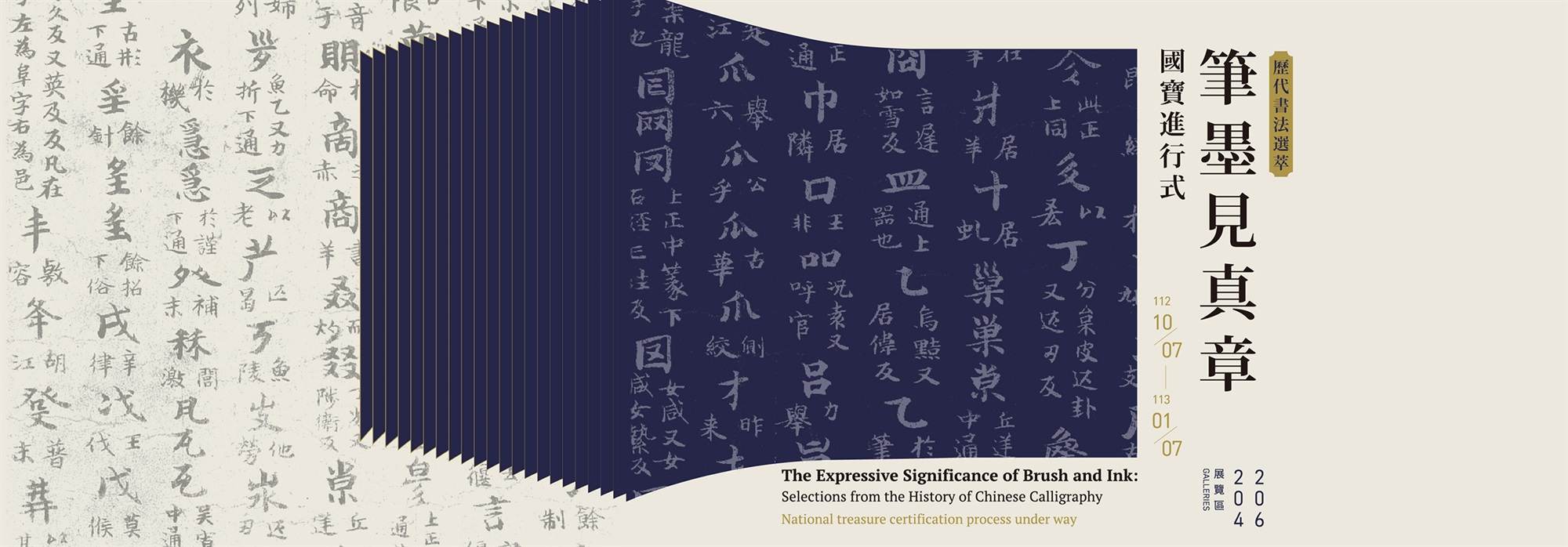Selections
-
Calligraphic “Tang Rhyming Dictionary”, Wu Cailuan, Tang dynasty
Wu Cailuan (9th century), who lived during the reign of Tang dynasty emperor Wenzong (809-840), was said to have accomplished the Tao, becoming a “Female Taoist Immortal.” According to legend, she made a living selling calligraphic transcriptions of rhyming dictionaries; her works were highly coveted by collectors throughout the ages due to their uniquely expansive style. Because of this, many of the handwritten copies of rhyming dictionaries extant in the world are forgeries bearing Wu’s name.
Entitled “Tang Rhyming Dictionary,” this album is a compilation of all the rhyming dictionaries available during the Tang dynasty. It was once held in the palace collection of Song dynasty emperor Huizong (r. 1100-1126). Arts restoration research has shown that this work originally appeared in a handscroll created with the historically rare method of “dragon scale binding,” before being remounted on album leaves at a later time. The marvelous precision of Tang dynasty regular script (kaishu) can be glimpsed in the calligraphy, which features broad and capacious character structures as well as solid and substantial brushwork. It is an exemplar of hand-copied books created during the Tang dynasty through Five Dynasties period.
-
Eulogy to the Chronicle of Ni Kuan, Chu Suiliang, Tang dynasty
Chu Suiliang, whose style name was Dengshan, was a native of Qiantang in Zhejiang province.
The brushwork gracing this scroll is spirited and natural, with a wealth of alternations between lightness and heaviness. The individual characters are beautifully proportionate, bringing a mood of placidity and refinement to the work. Commentators throughout the ages have primarily held that the calligraphy was written by Chu Suiliang (596-658) in his later years. However, other scholars have also pointed out that the usage of characters that were taboo because they were a part of emperors’ names differs from Tang dynasty customs. Additionally, the brushwork in the dots and lines differs from Chu’s calligraphic style, which had a sense of free-floating ease. The character structures are in fact closer to those found in Ouyang Xun’s calligraphy, leading to speculation that this was actually a copy of his work made during the Song dynasty.
-
Former Ode to the Red Cliff, Su Shi, Song dynasty
Su Shi (1037-1101), of Meishan in Sichuan province, was equally talented as a poet, essayist, calligrapher, and painter. He was one of the four masters of Northern Song dynasty calligraphy.
In 1082, Su Shi and several of his friends made two boat trips to view the Red Cliffs (located in present day Gang county in Hubei province). In order to record his observations and feelings, Su wrote two poetic essays (often called “odes”), known collectively as the “Former and Latter Odes to the Red Cliffs.” The writing is so elegantly beautiful and seems so deeply imprinted with philosophical sentiments that the odes became two of the most renowned writings in literary history. Su Shi wrote this calligraphic scroll in 1083 for a friend—it is the only surviving “Ode to the Red Cliffs” written in his own hand. His brushwork is steady and collected, while the ink is pure and luscious in hue. The calligraphy has a serene, unencumbered appearance that perfectly matches the broad-mindedness of the ode it transcribes.
-
Letter, Mi Fu (1052-1108), Song dynasty
Mi Fu was a famous painter-calligrapher and connoisseur of the Northern Song period known as “Southern Palace (Nangong) Mi.” He was fastidious about cleanliness and also had a large collection of decorative rocks. Due to his unbridled unconventional character, he was called “Madman Mi.”
Researchers note that this letter discusses group training for the baojia system initiated by Wang Anshi (1021-1086), suggesting that Mi wrote it in 1105. The calligraphy is slender and strong, the brush’s force leaving both horizontal and vertical strokes somewhat askew, such that the characters have highly changeable orientations. The brush’s tip is exposed in the dots and lines, set off naturally by the threadlike traces of ink between brushstrokes. Mi would have written this piece of calligraphy with great care.
-
Song on an Ancient Deflecting Mirror, Xianyu Shu, Yuan dynasty
Certified National Treasure
Xianyu Shu (1246-1302) had the style name Boji and the sobriquet Kunxuemin, which means “a student with diligence born of adversity.” His calligraphy was widely known for its rounded strength. Xian advocated for “restoring ancient ways”; he and Zhao Mengfu were known collectively as the “two marvels.”
Xianyu Shu had a lifelong affection for appraising and collecting calligraphy, paintings, and precious pieces of metal and stone. According to historical records, at one point he collected at a “deflecting mirror”—when it deflected a beam of light, wherever the projected beam landed could be seen patterns embedded behind the mirror’s surface. It was possibly because he had this rare treasure in his possession that Xianyu made a copy of Ma Jiuchou of the Jin dynasty’s poem entitled “An Ode to Boyu’s Deflecting Mirror.” The characters in this album have upright structures and an expansive bearing. With its powerful brush movements, this is one of the most representative works of Xianyu’s regular script (kaishu) calligraphy to have been passed down through the ages.


